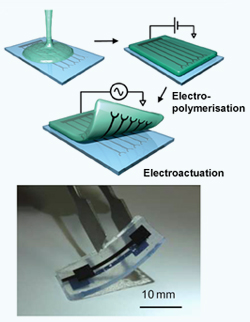Flexible, organic, moist electrodes have been designed by chemists in Japan. Composed of conductive polymers patterned onto slices of hydrogel, the biocompatible electrodes can function under wet conditions for up to a month – making them very useful in medical research.
Producing cheap and effective electrodes that work inside biological systems is crucial for designing implantable medical devices or monitoring the activity of cells in the body. Conductive polymers, such as PEDOT – poly(3,4-ethylenedioxythiophene) – have great potential for this application, but until now have been difficult to mount onto suitable substrates.
Conductive polymers are usually printed or stamped onto surfaces using a liquid polymer ‘ink’ which needs to dry, a process which does can’t be used with moist surfaces like hydrogels. To solve this problem, Matsuhiko Nishizawa and colleagues at Tohoku University developed a novel two-step system that uses electropolymerisation.
|
A simple two-step process is used to make the electrode. A double-sided hydrogel electrode can be seen below
© J. Am. Chem. Soc.
|

In this process, a platinum master electrode is made and liquid agarose gel is poured and set on top at a thickness of 2mm. A potential is then applied across the system, within an aqueous solution of the PEDOT monomer. This results in a thin layer of PEDOT forming on the hydrogel at the point of contact with the platinum master.
A further challenge that the team needed to overcome was peeling the hydrogel tablet away from the platinum without damaging it. To do this, Nishizawa made use of the natural electrochemical behaviour of PEDOT.
By reversibly reducing and oxidising the PEDOT, it can be made to contract and expand – causing the hydrogel tablet to curl up and peel itself away from the platinum plate. With repeated cycles, the tablet can be completely removed.
The team believes that this general strategy can be used to make more complicated patterns and also etch on other gels, such as collagen or fibrin. One example where they envisage the research being useful is to provide direct electrical stimulation to muscle tissue, such as in the heart.
Christine Schmidt, an expert in biomedical engineering at the University of Texas at Austin, US, is impressed by the research. ‘This work nicely illustrates a relatively simple approach, thus saving time and effort, to fabricate implantable sensors,’ she says. ‘It also provides a platform for creating “flexible” hydrogel sensors that can interface more efficiently with soft and contractile tissues and individual cells.’
original link
http://www.rsc.org/chemistryworld/News/2010/September/15091001.asp
